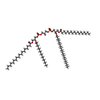+Search query
-Structure paper
| Title | Structural mechanism of mitochondrial membrane remodelling by human OPA1. |
|---|---|
| Journal, issue, pages | Nature, Vol. 620, Issue 7976, Page 1101-1108, Year 2023 |
| Publish date | Aug 23, 2023 |
 Authors Authors | Alexander von der Malsburg / Gracie M Sapp / Kelly E Zuccaro / Alexander von Appen / Frank R Moss / Raghav Kalia / Jeremy A Bennett / Luciano A Abriata / Matteo Dal Peraro / Martin van der Laan / Adam Frost / Halil Aydin /    |
| PubMed Abstract | Distinct morphologies of the mitochondrial network support divergent metabolic and regulatory processes that determine cell function and fate. The mechanochemical GTPase optic atrophy 1 (OPA1) ...Distinct morphologies of the mitochondrial network support divergent metabolic and regulatory processes that determine cell function and fate. The mechanochemical GTPase optic atrophy 1 (OPA1) influences the architecture of cristae and catalyses the fusion of the mitochondrial inner membrane. Despite its fundamental importance, the molecular mechanisms by which OPA1 modulates mitochondrial morphology are unclear. Here, using a combination of cellular and structural analyses, we illuminate the molecular mechanisms that are key to OPA1-dependent membrane remodelling and fusion. Human OPA1 embeds itself into cardiolipin-containing membranes through a lipid-binding paddle domain. A conserved loop within the paddle domain inserts deeply into the bilayer, further stabilizing the interactions with cardiolipin-enriched membranes. OPA1 dimerization through the paddle domain promotes the helical assembly of a flexible OPA1 lattice on the membrane, which drives mitochondrial fusion in cells. Moreover, the membrane-bending OPA1 oligomer undergoes conformational changes that pull the membrane-inserting loop out of the outer leaflet and contribute to the mechanics of membrane remodelling. Our findings provide a structural framework for understanding how human OPA1 shapes mitochondrial morphology and show us how human disease mutations compromise OPA1 functions. |
 External links External links |  Nature / Nature /  PubMed:37612504 / PubMed:37612504 /  PubMed Central PubMed Central |
| Methods | EM (helical sym.) |
| Resolution | 4.8 - 6.8 Å |
| Structure data | EMDB-26977, PDB-8ct1: EMDB-26984, PDB-8ct9: |
| Chemicals |  ChemComp-CDL: |
| Source |
|
 Keywords Keywords | MEMBRANE PROTEIN / GTPase / polymer / filament / membrane / remodeling / fusion / mitochondria |
 Movie
Movie Controller
Controller Structure viewers
Structure viewers About Yorodumi Papers
About Yorodumi Papers







 homo sapiens (human)
homo sapiens (human)